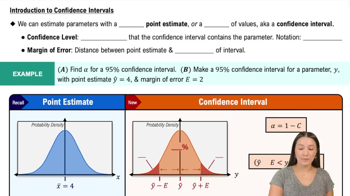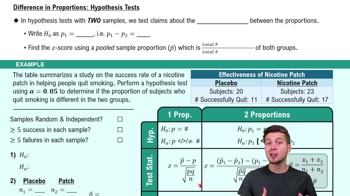Large Sample and a Small Difference It has been said that with really large samples, even very small differences between the sample mean and the claimed population mean can appear to be significant, but in reality they are not significant. Test this statement using the claim that the mean IQ score of adults is 100, given the following sample data: n = 1,000,000, x_bar = 100.05, s = 15 . Based on this sample, is the difference between x_bar = 100.05 and the claimed mean of 100 statistically significant? Does that difference have practical significance?
Table of contents
- 1. Intro to Stats and Collecting Data1h 14m
- 2. Describing Data with Tables and Graphs1h 55m
- 3. Describing Data Numerically2h 5m
- 4. Probability2h 16m
- 5. Binomial Distribution & Discrete Random Variables3h 6m
- 6. Normal Distribution and Continuous Random Variables2h 11m
- 7. Sampling Distributions & Confidence Intervals: Mean3h 23m
- Sampling Distribution of the Sample Mean and Central Limit Theorem19m
- Distribution of Sample Mean - Excel23m
- Introduction to Confidence Intervals15m
- Confidence Intervals for Population Mean1h 18m
- Determining the Minimum Sample Size Required12m
- Finding Probabilities and T Critical Values - Excel28m
- Confidence Intervals for Population Means - Excel25m
- 8. Sampling Distributions & Confidence Intervals: Proportion1h 12m
- 9. Hypothesis Testing for One Sample3h 29m
- 10. Hypothesis Testing for Two Samples4h 50m
- Two Proportions1h 13m
- Two Proportions Hypothesis Test - Excel28m
- Two Means - Unknown, Unequal Variance1h 3m
- Two Means - Unknown Variances Hypothesis Test - Excel12m
- Two Means - Unknown, Equal Variance15m
- Two Means - Unknown, Equal Variances Hypothesis Test - Excel9m
- Two Means - Known Variance12m
- Two Means - Sigma Known Hypothesis Test - Excel21m
- Two Means - Matched Pairs (Dependent Samples)42m
- Matched Pairs Hypothesis Test - Excel12m
- 11. Correlation1h 6m
- 12. Regression1h 50m
- 13. Chi-Square Tests & Goodness of Fit1h 57m
- 14. ANOVA1h 57m
9. Hypothesis Testing for One Sample
Steps in Hypothesis Testing
Problem 8.2.34c
Textbook Question
Using Confidence Intervals to Test Hypotheses When analyzing the last digits of telephone numbers in Port Jefferson, it is found that among 1000 randomly selected digits, 119 are zeros. If the digits are randomly selected, the proportion of zeros should be 0.1.
c. Use the sample data to construct a 95% confidence interval estimate of the proportion of zeros. What does the confidence interval suggest about the claim that the proportion of zeros equals 0.1?
 Verified step by step guidance
Verified step by step guidance1
Step 1: Identify the problem and the given data. The problem involves constructing a 95% confidence interval for the proportion of zeros in a sample. The given data includes the sample size (n = 1000), the number of zeros (x = 119), and the hypothesized proportion (p = 0.1).
Step 2: Calculate the sample proportion (p̂). The sample proportion is calculated as p̂ = x / n, where x is the number of zeros and n is the sample size. Substitute the values x = 119 and n = 1000 into the formula.
Step 3: Determine the standard error (SE) of the sample proportion. The formula for the standard error is SE = sqrt((p̂ * (1 - p̂)) / n). Substitute the calculated value of p̂ and the sample size n = 1000 into the formula.
Step 4: Find the critical value (z) for a 95% confidence level. For a 95% confidence interval, the critical value z is approximately 1.96. This value corresponds to the z-score that captures the middle 95% of the standard normal distribution.
Step 5: Construct the confidence interval. The formula for the confidence interval is p̂ ± z * SE. Substitute the values of p̂, z, and SE into the formula to calculate the lower and upper bounds of the confidence interval. Interpret the confidence interval to determine whether it supports or refutes the claim that the proportion of zeros equals 0.1.
 Verified video answer for a similar problem:
Verified video answer for a similar problem:This video solution was recommended by our tutors as helpful for the problem above
Video duration:
4mPlay a video:
Was this helpful?
Key Concepts
Here are the essential concepts you must grasp in order to answer the question correctly.
Confidence Interval
A confidence interval is a range of values, derived from sample statistics, that is likely to contain the true population parameter with a specified level of confidence, typically 95%. It provides an estimate of uncertainty around a sample statistic, allowing researchers to infer about the population. For example, if a 95% confidence interval for a proportion is calculated, it means that if the same sampling method were repeated many times, approximately 95% of the intervals would contain the true proportion.
Recommended video:

Introduction to Confidence Intervals
Proportion
In statistics, a proportion is a type of ratio that represents a part of a whole, often expressed as a fraction or percentage. In the context of the question, the proportion of zeros in the sample is calculated by dividing the number of zeros (119) by the total number of digits (1000), yielding a sample proportion. This value is crucial for constructing the confidence interval and testing hypotheses about the population proportion.
Recommended video:
Guided course

Difference in Proportions: Hypothesis Tests
Hypothesis Testing
Hypothesis testing is a statistical method used to make inferences or draw conclusions about a population based on sample data. It involves formulating a null hypothesis (e.g., the proportion of zeros equals 0.1) and an alternative hypothesis (e.g., the proportion of zeros does not equal 0.1). The results from the confidence interval can be used to determine if the null hypothesis can be rejected, providing insight into whether the sample data supports or contradicts the claim about the population proportion.
Recommended video:
Guided course

Step 1: Write Hypotheses

 6:21m
6:21mWatch next
Master Step 1: Write Hypotheses with a bite sized video explanation from Patrick
Start learningRelated Videos
Related Practice
Textbook Question
